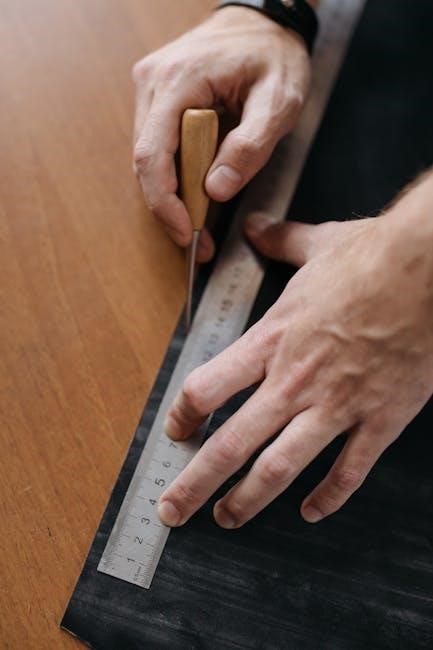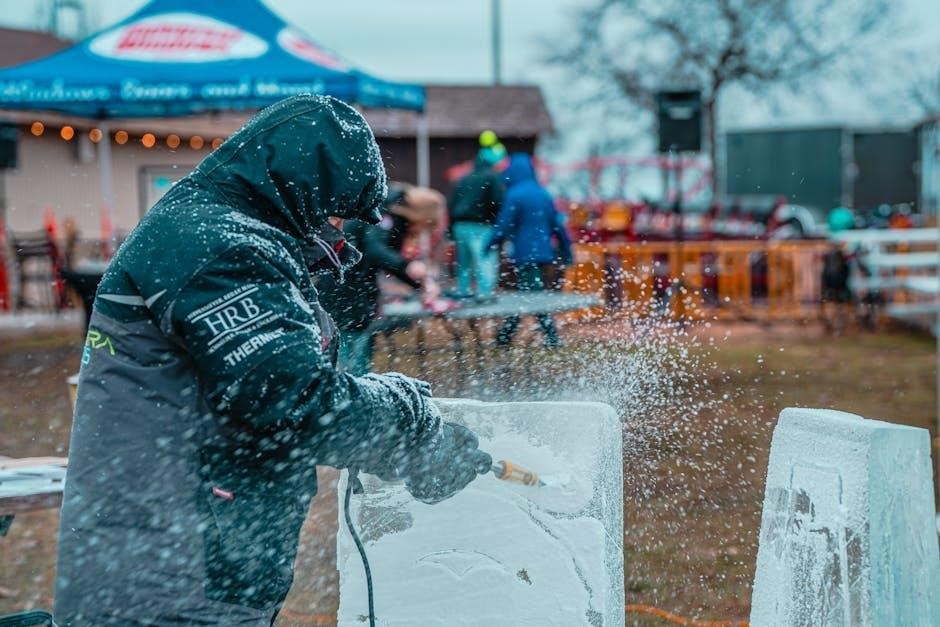Craftsman snow blowers are renowned for their reliability and durability, offering a range of models to suit diverse needs․ From electric to gas-powered options, these machines provide efficient snow clearing solutions․ With features like electric start, adjustable chute controls, and LED headlights, Craftsman snow blowers are designed for ease of use and optimal performance in harsh winter conditions․
1․1 Overview of Craftsman Snow Blower Models
Craftsman offers a diverse range of snow blower models, catering to various needs and preferences․ From lightweight electric snow throwers to powerful gas-powered dual-stage models, Craftsman provides options for small driveways and heavy-duty tasks․ Popular models include the Craftsman II 5/23 and the 31AM69PF599, known for their durability and performance․ Electric models are ideal for smaller areas, while gas models, like those with 8 horsepower, handle deeper snow and larger spaces․ Many models feature electric start, adjustable chutes, and LED headlights for enhanced visibility․ Craftsman snow blowers are designed to deliver efficiency, reliability, and ease of use, making them a favorite among homeowners and professionals alike․
1․2 Key Features and Benefits
Craftsman snow blowers are equipped with features that enhance performance and user experience․ Key features include electric start for effortless ignition and adjustable speed controls for varying snow conditions․ The dual-stage design ensures efficient snow intake and discharge, while LED headlights improve visibility in low-light conditions․ Many models offer remote chute controls, allowing users to adjust snow discharge direction without stopping․ Craftsman snow blowers also come with robust construction, including durable augers and high-quality tires for traction․ These features provide benefits such as reduced effort, faster clearing times, and improved safety․ Additionally, models with electric start options eliminate the need for pull-starting, making them more user-friendly․ These features collectively ensure that Craftsman snow blowers deliver reliable and efficient snow-clearing performance for homeowners and professionals․
1․3 Importance of Reading the User Guide
Reading the user guide for your Craftsman snow blower is essential for safe and effective operation․ It provides critical information on safety standards, operational guidelines, and maintenance tips․ The guide explains how to use features like electric start, remote chute controls, and speed adjustments properly․ Understanding these details ensures you operate the machine safely, avoiding potential hazards․ Additionally, the guide outlines routine maintenance procedures, such as lubrication and storage, to extend the lifespan of your snow blower․ By following the instructions, you can troubleshoot common issues like auger problems or starting difficulties․ Ignoring the guide may lead to improper use, damaging the machine or causing injury․ Always refer to it before using your snow blower to ensure optimal performance and safety․

Safety Precautions and Operational Guidelines
Always disconnect the spark plug before maintenance and wear protective gear․ Keep children away and avoid loose clothing․ Operate on stable ground and follow manual guidelines․
2․1 General Safety Tips for Snow Blower Use
Always wear protective gear, including gloves, safety glasses, and sturdy footwear․ Ensure the area is clear of obstacles and pedestrians․ Never leave the snow blower unattended while running․ Keep children and pets at a safe distance․ Avoid wearing loose clothing that could get caught in moving parts․ Use the machine only in well-ventilated areas to prevent carbon monoxide exposure․ Always disconnect the spark plug or power source before performing maintenance․ Follow the manufacturer’s guidelines for proper operation and never modify the equipment․ Be cautious of icy or uneven surfaces to maintain balance․ Keep the chute and auger clear of debris to prevent clogs․ Properly dispose of any flammable liquids and store fuel safely․ Regularly inspect the machine for worn or damaged parts․
2․2 Understanding Safety Standards and Regulations
Understanding safety standards and regulations is crucial for safe operation․ Craftsman snow blowers comply with industry safety standards, such as those set by ANSI (American National Standards Institute) and OSHA (Occupational Safety and Health Administration)․ These standards ensure the equipment is designed to minimize risks, with features like operator presence controls and protective guards․ Familiarize yourself with local regulations regarding noise levels and emissions․ Always adhere to the manufacturer’s guidelines, as they align with these standards․ Compliance ensures not only personal safety but also legal adherence․ Regular inspections and proper maintenance help maintain compliance and optimal performance․ Stay informed about updates to safety standards to ensure ongoing adherence․ Safety standards are in place to protect users, so understanding and following them is essential for a safe experience․
2․3 Pre-Operation Checks and Safety Gear

Before starting your Craftsman snow blower, conduct a thorough pre-operation check․ Inspect the auger, chute, and belts for damage or wear․ Ensure all nuts and bolts are tightened, and check the scraper bar for proper alignment․ Verify that the tires are inflated to the recommended pressure and that all controls function smoothly․ Always wear appropriate safety gear, including gloves, goggles, and sturdy, non-slip boots․ Reflective clothing can enhance visibility in low-light conditions․ Avoid loose clothing that could get caught in moving parts․ Keep long hair tied back and avoid jewelry․ Ensure the area is clear of obstacles and people․ Proper preparation and attire are essential for safe and efficient snow clearing․

Assembly and Initial Setup
Unbox and verify all parts are included․ Follow step-by-step assembly instructions carefully․ Apply initial lubrication to moving components and adjust settings as specified in the manual․
3․1 Unboxing and Inventory of Parts
Begin by carefully unboxing your Craftsman snow blower to ensure all components are accounted for․ Check for the main unit, handle, chute, auger, and hardware package․ Compare the contents with the parts list in the manual to confirm nothing is missing․ Pay attention to small items like bolts, screws, and any additional accessories․ If any parts are damaged or missing, contact customer support immediately․ Organize the parts neatly to avoid losing any during assembly․ This step ensures a smooth setup process and prevents delays․ Taking the time to inventory everything now saves frustration later․
3․2 Step-by-Step Assembly Instructions
Begin by attaching the handle to the main unit using the provided bolts and washers․ Ensure the handle is securely tightened but not over-torqued․ Next, install the chute assembly by aligning the mounting brackets and fastening with the included hardware․ Partially tighten these bolts to allow for adjustments later․ Attach the auger housing to the front of the snow blower, making sure it aligns properly with the engine․ Use the eye bolt and handle knob on the upper handle as shown in the manual․ Tighten all hardware once everything is in place․ Refer to Figure 6 in the manual for precise instructions․ If unsure, consult the official Craftsman assembly guide or visit their website for additional resources․
3․3 Initial Lubrication and Adjustment
Apply a thin layer of automotive grease to all moving parts, including gears and hinges, to ensure smooth operation․ Lubricate the engine with the recommended oil type, as specified in the manual․ Avoid over-lubrication, as it may attract dirt․ Adjust the chute and auger to their neutral positions for balanced performance․ Tighten all bolts and screws after adjustments․ Refer to the manual for specific lubrication points and quantities․ Perform a test run to ensure all components function properly․ If unsure, consult the official Craftsman guide for detailed instructions․ Proper lubrication and adjustment are crucial for optimal performance and longevity of your snow blower․

Operating the Craftsman Snow Blower
Start the snow blower by following the manufacturer’s instructions for electric or pull start․ Adjust speed and direction controls for optimal performance․ Clear snow efficiently by maintaining a steady pace and using the chute to direct snow away from people and property․ Always keep loose clothing tied back and avoid overreaching․ Regularly check and refill fuel or charge the battery as needed․ Ensure the area is free of debris to prevent damage or clogging․ Refer to the user guide for specific operational tips and safety measures to ensure smooth and effective snow clearing․
4․1 Starting the Snow Blower (Electric vs․ Pull Start)
Starting your Craftsman snow blower varies slightly depending on whether it’s an electric or pull-start model․ For electric start models, simply plug in the unit, ensure the safety switch is engaged, and press the start button․ Some models may require a quick pull of the choke lever before starting․ Pull-start models require a firm pull of the recoil starter cord, often after priming the engine and engaging the choke․ Always ensure the snow blower is on a flat, stable surface and the area is clear of debris; Refer to your user guide for specific starting procedures, as slight differences may exist between models․ Proper starting techniques ensure reliability and longevity of your snow blower․ Always wear safety gear and follow the manufacturer’s guidelines․
4․2 Adjusting Speed and Direction Controls
Adjusting the speed and direction controls on your Craftsman snow blower is essential for efficient snow clearing․ Most models feature variable speed settings, allowing you to customize the auger and drive system to match snow conditions․ For direction control, the chute deflector can be rotated to direct snow up to 190 degrees, while the crank or joystick adjusts the discharge height․ Electric models often include convenient handle-mounted controls, while gas-powered units may have manual or power steering options․ Always adjust settings slowly and deliberately to maintain control․ Proper use of these controls ensures even snow distribution and reduces operator fatigue․ Refer to your user guide for specific instructions tailored to your model․
4․3 Best Practices for Clearing Snow Efficiently
For efficient snow clearing with your Craftsman snow blower, start by removing doormats, cables, and other obstacles to ensure a smooth path․ Clear snow in sections, working in consistent, overlapping passes to avoid missing spots․ Adjust the chute deflector to direct snow away from windows, plants, and vehicles․ When encountering deep snow, reduce your speed to prevent clogging the auger․ Use the appropriate speed setting for the snow depth—higher speeds for lighter snow and lower speeds for heavy, wet snow․ Avoid overloading the machine, as this can reduce performance․ Finally, after clearing, inspect the area for any remaining snow or debris and ensure all surfaces are even and safe․


Maintenance and Upkeep
Regular maintenance ensures optimal performance and longevity․ Schedule routine checks, lubricate moving parts, and change oil as recommended․ Store the snow blower properly after winter․
5․1 Routine Maintenance Schedule
A routine maintenance schedule is essential to keep your Craftsman snow blower running smoothly․ Start by checking the oil level before each use and changing it annually․ Inspect the auger and impeller for damage or wear, and replace any worn parts promptly․ Lubricate the drive system and moving components every 10 hours of use to prevent friction and corrosion․ Additionally, ensure the tires are properly inflated and the chute is free from debris․ After each snow-clearing session, clean the machine thoroughly to remove any residual snow and ice․ Following this schedule will help extend the life of your snow blower and ensure reliable performance during winter․
5․2 Lubrication and Oil Change Guidelines
Regular lubrication and oil changes are crucial for maintaining your Craftsman snow blower’s performance․ Use SAE 5W-30 oil for optimal viscosity in cold temperatures․ Change the oil after the first 5 hours of use and annually thereafter․ Drain the old oil responsibly and replace the filter if equipped․ Lubricate pivot points, such as the auger gear box and drive system, with lithium-based grease every 10 hours of operation․ Avoid over-lubricating to prevent attracting dirt․ Always refer to your owner’s manual for specific oil capacity and recommended lubrication points․ Proper oil and grease maintenance ensures smooth operation and extends the lifespan of your snow blower․
5․3 Storing the Snow Blower After Winter
Proper storage of your Craftsman snow blower after winter is essential to maintain its performance and longevity․ Drain the fuel tank or use a fuel stabilizer to prevent corrosion․ Clean the machine thoroughly, removing dirt and debris from the auger, chute, and other components․ Apply a light coat of rust-inhibiting oil to metal parts․ Store the snow blower in a dry, protected area away from direct sunlight and moisture․ Check and tighten any loose bolts or screws․ If storing for an extended period, consider covering the unit to protect it from dust․ Always follow the manufacturer’s storage recommendations to ensure your snow blower is ready for the next winter season․

Troubleshooting Common Issues
Craftsman snow blowers may face issues like auger stoppage or starting problems․ Always consult the user manual for diagnostic guidance․ Common fixes include checking belts, spark plugs, and fuel quality․ Visit Sears Parts Direct for replacement parts and repair advice to resolve issues efficiently․

6․1 Diagnosing Common Problems (e․g․, Auger Not Turning)
A common issue with Craftsman snow blowers is the auger not turning, which can stop snow clearing entirely․ This problem is often caused by a broken or loose belt, a jammed auger, or issues with the drive system․ To diagnose, inspect the belt for cracks or wear and ensure it is properly aligned․ Check for debris clogging the auger housing and clear any blockages․ If the belt is damaged, replace it with a genuine Craftsman part․ Additionally, ensure all drive chains are lubricated and functioning correctly․ Refer to the user manual for specific troubleshooting steps, and consult Sears Parts Direct for replacement parts if needed․ Regular maintenance can prevent such issues and ensure smooth operation during winter․
6․2 Repairing or Replacing Parts (e․g․, Belts, Chains)
Repairing or replacing parts like belts and chains is essential for maintaining your Craftsman snow blower’s performance․ Always disconnect the spark plug before starting any repair to ensure safety․ For a broken belt, inspect the pulleys for alignment issues and clean any debris․ Replace the belt with a genuine Craftsman part, ensuring it matches the model specifications․ For chains, lubricate regularly to prevent rust and wear․ If a chain is damaged, replace it by aligning the new chain properly and tightening it as per the manual․ Sears Parts Direct offers a wide range of replacement parts, making it easy to find what you need․ Proper maintenance and timely repairs will extend the life of your snow blower and keep it running efficiently throughout the winter season․
6․3 Solving Starting Issues (Electric vs․ Gas Models)
Starting issues with Craftsman snow blowers can vary between electric and gas models․ For electric models, ensure the power cord is securely plugged into a working outlet․ Check for tripped circuit breakers or blown fuses․ If the motor overheats, allow it to cool before restarting․ For gas models, old or stale fuel is a common culprit․ Drain the tank and refill with fresh gasoline․ A clogged carburetor or faulty spark plug may also prevent starting․ Consult the user manual for specific troubleshooting steps․ Always disconnect the spark plug before performing any repairs․ If issues persist, contact a certified technician․ Regular maintenance, such as checking the air filter and oil levels, can help prevent starting problems․ Proper care ensures your snow blower is ready to tackle winter weather effectively․

Winterizing and Seasonal Preparation
Winterizing your Craftsman snow blower ensures optimal performance and longevity․ Drain old fuel, lubricate moving parts, and store in a dry, protected area․ Regular maintenance guarantees readiness for the next winter season․
7․1 Preparing the Snow Blower for Winter Use
Preparing your Craftsman snow blower for winter ensures it operates efficiently․ Start by checking the fuel and oil levels, ensuring they are fresh and suitable for cold temperatures․ Inspect the auger and blades for wear or damage, sharpening them if necessary․ Lubricate all moving parts, such as the chute and auger bearings, to prevent rust and friction․ Check belts and hoses for cracks or fraying, replacing them if needed․ Test the electrical system, including the start switch and headlights, to ensure proper function․ Finally, clear any debris from the chute and discharge area to maintain smooth operation․ A well-prepared snow blower will handle winter conditions effectively, providing reliable performance when needed most․
7․2 Winter Storage Best Practices
Proper winter storage of your Craftsman snow blower is essential to maintain its performance and longevity․ Begin by draining the fuel tank or using a fuel stabilizer to prevent corrosion․ Clean the machine thoroughly, removing any dirt or debris that may cause rust․ Lubricate all moving parts, such as the auger and chute, to protect them from moisture․ Store the snow blower in a dry, protected area away from direct sunlight and extreme temperatures․ Ensure the storage location is well-ventilated to prevent moisture buildup․ Check for any visible damage or wear and address it before storing․ By following these steps, your Craftsman snow blower will remain in optimal condition, ready for the next winter season․
7․3 Post-Winter Maintenance and Cleaning
After the winter season, proper cleaning and maintenance of your Craftsman snow blower are crucial to ensure its longevity․ Start by removing any leftover snow and debris from the exterior and chute․ Inspect the machine for any damage or wear, particularly on the auger and blades․ Lubricate all moving parts to prevent rust and corrosion․ Check and replace worn belts or chains if necessary․ Drain any remaining fuel or use a fuel stabilizer to prevent degradation․ Clean the air filter and spark plug, and store the snow blower in a dry, protected area․ Regular post-winter maintenance ensures your Craftsman snow blower remains in peak condition for future use․